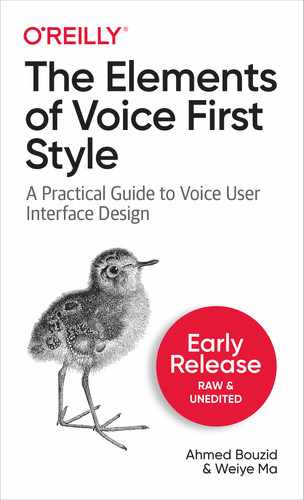If you're a new or experienced designer of conversational voice-first experiences, this handy reference provides actionable answers to key aspects of eyes-busy, hands-busy, voice-only user interfaces. Designed as a companion to books about conversational voice design, this guide includes important details regarding eyes-free, hands-free, voice-only interfaces delivered by Amazon Echo, Google Nest, and a variety of in-car experiences. Authors Ahmed Bouzid and Weiye Ma provide far-field voice best practices and recommendations in a manner similar to The Elements of Style, the popular American English writing style guide. Like that book, The Elements of Voice First Style provides direct, succinct explanations that focus on the essence of each topic. You'll find answers quickly without having to spend time searching through other sources. With this guide, you'll be able to:
Table of Contents
- Preface
- 1. The Elements of Conversation
- The Ontology of Conversations
- The Conversational Actions
- Start Conversation
- Articulate content
- Offer Turn
- Request Turn
- Cede Turn
- Retain Turn
- Seize Turn
- Interrupt
- Pause
- Resume after Pause
- Repeat
- Start Over
- Terminate
- The Conversational States
- The Internal Conversational Context
- Conversational Signalling
- Signaling States
- Signaling Transitions
- 2. The Rules of Conversation
- 3. The Basic Tenets
- 4. The Extra-Conversational Context
- 5. The UI-Use Case Fit
- 6. The Elements of Starting
- 1. Be brief
- 2. Use an audio icon
- 3. Drop the “Welcome to...”
- 4. Never ever say, “Please listen carefully as our options have changed”
- 5. Have the voicebot refer to itself in the first person
- 6. Drop “You can interrupt me at any time”
- 7. Keep the origination context in mind
- 8. Remember the user’s preferences
- 9. Anticipate user-specific requests
- 10. Anticipate general user-base requests
